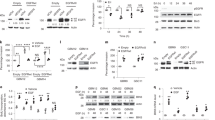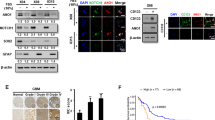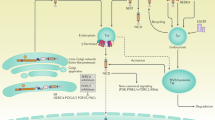Abstract
The Notch1-mediated signaling pathway has a central role in the maintenance of neural stem cells and contributes to growth and progression of glioblastomas, the most frequent malignant brain tumors in adults. Here, we demonstrate that the Notch1 receptor promotes survival of glioblastoma cells by regulation of the anti-apoptotic Mcl-1 protein. Notch1-dependent regulation of Mcl-1 occurs cell type dependent at a transcriptional or post-translational level and is mediated by the induction of epidermal growth factor receptor (EGFR). Inhibition of the Notch1 pathway overcomes apoptosis resistance and sensitizes glioblastoma cells to apoptosis induced by ionizing radiation, the death ligand TRAIL (tumor necrosis factor-related apoptosis-inducing ligand) or the Bcl-2/Bcl-XL inhibitor ABT-737. In conclusion, targeting Notch1 might represent a promising novel strategy in the treatment of glioblastomas.
This is a preview of subscription content, access via your institution
Access options
Subscribe to this journal
Receive 50 print issues and online access
$259.00 per year
only $5.18 per issue
Buy this article
- Purchase on Springer Link
- Instant access to full article PDF
Prices may be subject to local taxes which are calculated during checkout







Similar content being viewed by others
References
Artavanis-Tsakonas S, Rand MD, Lake RJ . Notch signaling: cell fate control and signal integration in development. Science 1999; 284: 770–776.
Kopan R, Ilagan MX . The canonical Notch signaling pathway: unfolding the activation mechanism. Cell 2009; 137: 216–233.
Purow BW, Haque RM, Noel MW, Su Q, Burdick MJ, Lee J et al. Expression of Notch-1 and its ligands, Delta-like-1 and Jagged-1, is critical for glioma cell survival and proliferation. Cancer Res 2005; 65: 2353–2363.
Kanamori M, Kawaguchi T, Nigro JM, Feuerstein BG, Berger MS, Miele L et al. Contribution of Notch signaling activation to human glioblastoma multiforme. J Neurosurg 2007; 106: 417–427.
Zhang XP, Zheng G, Zou L, Liu HL, Hou LH, Zhou P et al. Notch activation promotes cell proliferation and the formation of neural stem cell-like colonies in human glioma cells. Mol Cell Biochem 2008; 307: 101–108.
Xu P, Qiu M, Zhang Z, Kang C, Jiang R, Jia Z et al. The oncogenic roles of Notch1 in astrocytic gliomas in vitro and in vivo. J Neurooncol 2010; 97: 41–51.
Oishi K, Kamakura S, Isazawa Y, Yoshimatsu T, Kuida K, Nakafuku M et al. Notch promotes survival of neural precursor cells via mechanisms distinct from those regulating neurogenesis. Dev Biol 2004; 276: 172–184.
Liu WH, Hsiao HW, Tsou WI, Lai MZ . Notch inhibits apoptosis by direct interference with XIAP ubiquitination and degradation. EMBO J 2007; 26: 1660–1669.
Wang J, Wakeman TP, Lathia JD, Hjelmeland AB, Wang XF, White RR et al. Notch promotes radioresistance of glioma stem cells. Stem Cells 2010; 28: 17–28.
Mungamuri SK, Yang X, Thor AD, Somasundaram K . Survival signaling by Notch1: mammalian target of rapamycin (mTOR)-dependent inhibition of p53. Cancer Res 2006; 66: 4715–4724.
Singh SK, Hawkins C, Clarke ID, Squire JA, Bayani J, Hide T et al. Identification of human brain tumour initiating cells. Nature 2004; 432: 396–401.
Galli R, Binda E, Orfanelli U, Cipelletti B, Gritti A, De Vitis S et al. Isolation and characterization of tumorigenic, stem-like neural precursors from human glioblastoma. Cancer Res 2004; 64: 7011–7021.
Sanai N, Alvarez-Buylla A, Berger MS . Neural stem cells and the origin of gliomas. N Engl J Med 2005; 353: 811–822.
Lee J, Kotliarova S, Kotliarov Y, Li A, Su Q, Donin NM et al. Tumor stem cells derived from glioblastomas cultured in bFGF and EGF more closely mirror the phenotype and genotype of primary tumors than do serum-cultured cell lines. Cancer Cell 2006; 9: 391–403.
Koch P, Opitz T, Steinbeck JA, Ladewig J, Brustle O . A rosette-type, self-renewing human ES cell-derived neural stem cell with potential for in vitro instruction and synaptic integration. Proc Natl Acad Sci USA 2009; 106: 3225–3230.
Campos B, Wan F, Farhadi M, Ernst A, Zeppernick F, Tagscherer KE et al. Differentiation therapy exerts antitumor effects on stem-like glioma cells. Clin Cancer Res 2010; 16: 2715–2728.
Verhaak RG, Hoadley KA, Purdom E, Wang V, Qi Y, Wilkerson MD et al. Integrated genomic analysis identifies clinically relevant subtypes of glioblastoma characterized by abnormalities in PDGFRA, IDH1, EGFR, and NF1. Cancer Cell 2010; 17: 98–110.
Zhu Y, Guignard F, Zhao D, Liu L, Burns DK, Mason RP et al. Early inactivation of p53 tumor suppressor gene cooperating with NF1 loss induces malignant astrocytoma. Cancer Cell 2005; 8: 119–130.
Miele L, Osborne B . Arbiter of differentiation and death: Notch signaling meets apoptosis. J Cell Physiol 1999; 181: 393–409.
Brou C, Logeat F, Gupta N, Bessia C, LeBail O, Doedens JR et al. A novel proteolytic cleavage involved in Notch signaling: the role of the disintegrin-metalloprotease TACE. Mol Cell 2000; 5: 207–216.
van Tetering G, van Diest P, Verlaan I, van der Wall E, Kopan R, Vooijs M . Metalloprotease ADAM10 is required for Notch1 site 2 cleavage. J Biol Chem 2009; 284: 31018–31027.
Opferman JT . Unraveling MCL-1 degradation. Cell Death Differ 2006; 13: 1260–1262.
Thomas LW, Lam C, Edwards SW . Mcl-1; the molecular regulation of protein function. FEBS Lett 2010; 584: 2981–2989.
Weng C, Li Y, Xu D, Shi Y, Tang H . Specific cleavage of Mcl-1 by caspase-3 in tumor necrosis factor-related apoptosis-inducing ligand (TRAIL)-induced apoptosis in Jurkat leukemia T cells. J Biol Chem 2005; 280: 10491–10500.
Schwickart M, Huang X, Lill JR, Liu J, Ferrando R, French DM et al. Deubiquitinase USP9X stabilizes MCL1 and promotes tumour cell survival. Nature 2010; 463: 103–107.
Maurer U, Charvet C, Wagman AS, Dejardin E, Green DR . Glycogen synthase kinase-3 regulates mitochondrial outer membrane permeabilization and apoptosis by destabilization of MCL-1. Mol Cell 2006; 21: 749–760.
Inoshita S, Takeda K, Hatai T, Terada Y, Sano M, Hata J et al. Phosphorylation and inactivation of myeloid cell leukemia 1 by JNK in response to oxidative stress. J Biol Chem 2002; 277: 43730–43734.
Libermann TA, Nusbaum HR, Razon N, Kris R, Lax I, Soreq H et al. Amplification, enhanced expression and possible rearrangement of EGF receptor gene in primary human brain tumours of glial origin. Nature 1985; 313: 144–147.
Leu CM, Chang C, Hu C . Epidermal growth factor (EGF) suppresses staurosporine-induced apoptosis by inducing mcl-1 via the mitogen-activated protein kinase pathway. Oncogene 2000; 19: 1665–1675.
Yoon JH, Werneburg NW, Higuchi H, Canbay AE, Kaufmann SH, Akgul C et al. Bile acids inhibit Mcl-1 protein turnover via an epidermal growth factor receptor/Raf-1-dependent mechanism. Cancer Res 2002; 62: 6500–6505.
Sheng Z, Li L, Zhu LJ, Smith TW, Demers A, Ross AH et al. A genome-wide RNA interference screen reveals an essential CREB3L2-ATF5-MCL1 survival pathway in malignant glioma with therapeutic implications. Nat Med 2010; 16: 671–677.
Purow BW, Sundaresan TK, Burdick MJ, Kefas BA, Comeau LD, Hawkinson MP et al. Notch-1 regulates transcription of the epidermal growth factor receptor through p53. Carcinogenesis 2008; 29: 918–925.
Baumgart A, Seidl S, Vlachou P, Michel L, Mitova N, Schatz N et al. ADAM17 regulates epidermal growth factor receptor expression through the activation of Notch1 in non-small cell lung cancer. Cancer Res 2010; 70: 5368–5378.
van Delft MF, Wei AH, Mason KD, Vandenberg CJ, Chen L, Czabotar PE et al. The BH3 mimetic ABT-737 targets selective Bcl-2 proteins and efficiently induces apoptosis via Bak/Bax if Mcl-1 is neutralized. Cancer Cell 2006; 10: 389–399.
Henson ES, Gibson EM, Villanueva J, Bristow NA, Haney N, Gibson SB . Increased expression of Mcl-1 is responsible for the blockage of TRAIL-induced apoptosis mediated by EGF/ErbB1 signaling pathway. J Cell Biochem 2003; 89: 1177–1192.
Han J, Goldstein LA, Gastman BR, Rabinowich H . Interrelated roles for Mcl-1 and BIM in regulation of TRAIL-mediated mitochondrial apoptosis. J Biol Chem 2006; 281: 10153–10163.
Tagscherer KE, Fassl A, Campos B, Farhadi M, Kraemer A, Bock BC et al. Apoptosis-based treatment of glioblastomas with ABT-737, a novel small molecule inhibitor of Bcl-2 family proteins. Oncogene 2008; 27: 6646–6656.
Capper D, Gaiser T, Hartmann C, Habel A, Mueller W, Herold-Mende C et al. Stem-cell-like glioma cells are resistant to TRAIL/Apo2L and exhibit down-regulation of caspase-8 by promoter methylation. Acta Neuropathol 2009; 117: 445–456.
Furnari FB, Fenton T, Bachoo RM, Mukasa A, Stommel JM, Stegh A et al. Malignant astrocytic glioma: genetics, biology, and paths to treatment. Genes Dev 2007; 21: 2683–2710.
Pierfelice TJ, Schreck KC, Eberhart CG, Gaiano N . Notch, neural stem cells, and brain tumors. Cold Spring Harb Symp Quant Biol 2008; 73: 367–375.
Fan X, Khaki L, Zhu TS, Soules ME, Talsma CE, Gul N et al. NOTCH pathway blockade depletes CD133-positive glioblastoma cells and inhibits growth of tumor neurospheres and xenografts. Stem Cells 2010; 28: 5–16.
Liu ZJ, Xiao M, Balint K, Smalley KS, Brafford P, Qiu R et al. Notch1 signaling promotes primary melanoma progression by activating mitogen-activated protein kinase/phosphatidylinositol 3-kinase-Akt pathways and up-regulating N-cadherin expression. Cancer Res 2006; 66: 4182–4190.
Arbour N, Vanderluit JL, Le Grand JN, Jahani-Asl A, Ruzhynsky VA, Cheung EC et al. Mcl-1 is a key regulator of apoptosis during CNS development and after DNA damage. J Neurosci 2008; 28: 6068–6078.
Krajewski S, Krajewska M, Ehrmann J, Sikorska M, Lach B, Chatten J et al. Immunohistochemical analysis of Bcl-2, Bcl-X, Mcl-1, and Bax in tumors of central and peripheral nervous system origin. Am J Pathol 1997; 150: 805–814.
Masuoka HC, Mott J, Bronk SF, Werneburg NW, Akazawa Y, Kaufmann SH et al. Mcl-1 degradation during hepatocyte lipoapoptosis. J Biol Chem 2009; 284: 30039–30048.
Schultz A, Jonsson JI, Larsson C . The regulatory domain of protein kinase Ctheta localises to the Golgi complex and induces apoptosis in neuroblastoma and Jurkat cells. Cell Death Differ 2003; 10: 662–675.
Chen J, Kesari S, Rooney C, Strack PR, Shen H, Wu L et al. Inhibition of notch signaling blocks growth of glioblastoma cell lines and tumor neurospheres. Genes Cancer 2010; 1: 822–835.
Karcher S, Steiner HH, Ahmadi R, Zoubaa S, Vasvari G, Bauer H et al. Different angiogenic phenotypes in primary and secondary glioblastomas. Int J Cancer 2006; 118: 2182–2189.
Schmidt MH, Bicker F, Nikolic I, Meister J, Babuke T, Picuric S et al. Epidermal growth factor-like domain 7 (EGFL7) modulates Notch signalling and affects neural stem cell renewal. Nat Cell Biol 2009; 11: 873–880.
Roth W, Isenmann S, Naumann U, Kugler S, Bahr M, Dichgans J et al. Locoregional Apo2L/TRAIL eradicates intracranial human malignant glioma xenografts in athymic mice in the absence of neurotoxicity. Biochem Biophys Res Commun 1999; 265: 479–483.
Acknowledgements
We thank Tabea Sinkovic and Martina Keith for technical assistance. We further thank Anja Reimann (Molecular Metabolic Control, DKFZ, Heidelberg, Germany) for help with purification of recombinant adenoviruses, David Capper, David Reuss and Andreas v Deimling (Department of Neuropathology, University of Heidelberg, Germany) for providing histological sections of glioblastomas and Tamara Quandel, Lodovica Borghese, Philipp Koch and Oliver Brüstle (Institute of Reconstructive Neurobiology, Life and Brain, Bonn, Germany) for providing cell pellets and RNA from neural stem cells. This work was supported by a grant from the Deutsche Krebshilfe to WR (German Cancer Aid, Max Eder Program).
Author information
Authors and Affiliations
Corresponding author
Ethics declarations
Competing interests
The authors declare no conflict of interest.
Additional information
Supplementary Information accompanies the paper on the Oncogene website
Supplementary information
Rights and permissions
About this article
Cite this article
Fassl, A., Tagscherer, K., Richter, J. et al. Notch1 signaling promotes survival of glioblastoma cells via EGFR-mediated induction of anti-apoptotic Mcl-1. Oncogene 31, 4698–4708 (2012). https://doi.org/10.1038/onc.2011.615
Received:
Revised:
Accepted:
Published:
Issue Date:
DOI: https://doi.org/10.1038/onc.2011.615
Keywords
This article is cited by
-
Inducing apoptosis by using microRNA in radio-resistant prostate cancer: an in-silico study with an in-vitro validation
Molecular Biology Reports (2023)
-
A computational guided, functional validation of a novel therapeutic antibody proposes Notch signaling as a clinical relevant and druggable target in glioma
Scientific Reports (2020)
-
NKAP alters tumor immune microenvironment and promotes glioma growth via Notch1 signaling
Journal of Experimental & Clinical Cancer Research (2019)
-
A novel Notch1 missense mutation (C1133Y) in the Abruptex domain exhibits enhanced proliferation and invasion in oral squamous cell carcinoma
Cancer Cell International (2018)
-
MicroRNA-210 induces apoptosis in colorectal cancer via induction of reactive oxygen
Cancer Cell International (2016)



